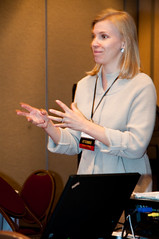Infinite Story, Finite Space
Chris Stapleton, co-chair of ISMAR09, gave us his vision for augmented reality and told us about the projects he's worked on. He says "we think that if we deal with physical space, we can only deal with one story." But if the augmentations can change, this is no longer true. Using augmented reality, we can allow users to add their imagination, rather than just give them the story - imagination is the third reality.
A project that really intrigued me was a memory scape for the Maitland Holocaust Museum. The idea was to recreate stories told in children's diaries of the Holocaust so visitors could understand what happened in terms of humanity. A physical space would be created, and embedded projections used to bring the space to life. Bits and pieces of the story can be told through these augmentations, and imagination can fill in the rest. Even better, you could experience a different story each time you visited the museum.
Chris goes on to lay out the spectrum of levels of engagement:
- Passive : Absorb the media (TV)
- Engaging : Think and feel (film)
- Active : Participate (amusement park rides)
- Reactive : Choose (games)
- Interactive : Contribute (Second Life)
- Experiential : Live (enhanced media? augmented reality?)
Total Immersion
Unfortunately I didn't catch the presenter's name (wasn't on slides, didn't see it in the schedule), but he was from Total Immersion. He pointed out that 20-30% of the population are auditory learners, 40% are visual, and 30-40% are kinaesthetic. Naturally, augmented reality helps the kinaesthetic learning type unlike many other mediums. Experiences will allow for engagement, reflection, insight, and of course, learning.
Also touched on was a set of best practices for augmented reality. It needs to attract users, be easy to use, and give instant access to the experience.
Finally, a comparison between entertainment and education was made to highlight some of the differences.
Entertainment:
- Audience: Groups
- Duration: Quick
- Engagement: Immediate gratification
- Outcome: Something immersive or magical
- Audience: Small groups or individuals
- Duration: Long term engagement
- Engagement: Deep exploration
- Outcome: A new visual perspective on topic of study
Museum Learning and AR
Last but not least, we have Kate Haley Goldman from the Institute for Learning Innovation. She's all about informal and free choice learning, creating voluntary, non-sequential learning experiences like Wolf Quest. Though Wolf Quest is not a space-based game, it's interesting nonetheless for its great success; kids played it much longer than the expected two to three hours it was designed for.
Kate explained that personal, sociocultural, and physical context are all factors that help influence learning. These are all things that can be employed in, say, museum exhibits. But why do people visit museums? Research has shown that reasons range from fun and entertainment, to social activity, to being a site of interest (a 'must-see' while on vacation), or even specifically to be challenged or learn something. How might augmented reality help with all this?
One project Kate talked about was an AR system that augmented the wing of a plane. Visitors could adjust various settings or move the wing, and see the resulting forces in the augmentation. They could then figure out whether the plane would actually fly under those conditions. This system helped with some of the above goals (especially learning, as tests showed), but not all. For example, the system was too separated and thus lacked the social aspect of a museum visit. Users couldn't really talk to or interact with each other.
Some of the aspirations of augmented reality that Kate mentioned were:
- creating conversations
- making the abstract tangible
- helping visualize change
- adding sensory capabilities
- supporting critical thinking skills
- ability to act like a scientist (collect data, form and test theories)




0 comments:
Post a Comment
Comments are moderated - please be patient while I approve yours.
Note: Only a member of this blog may post a comment.